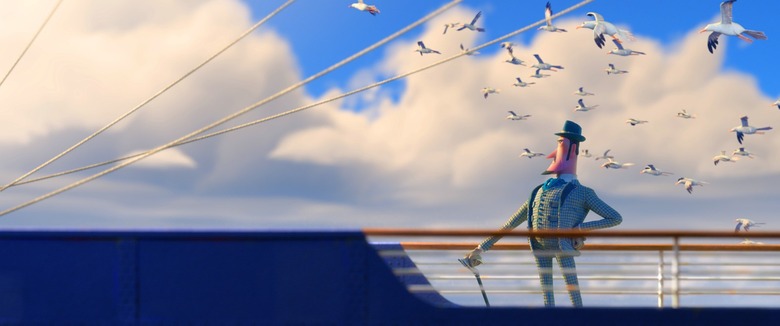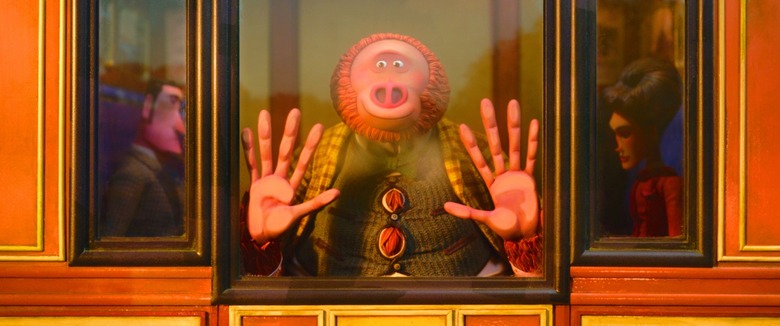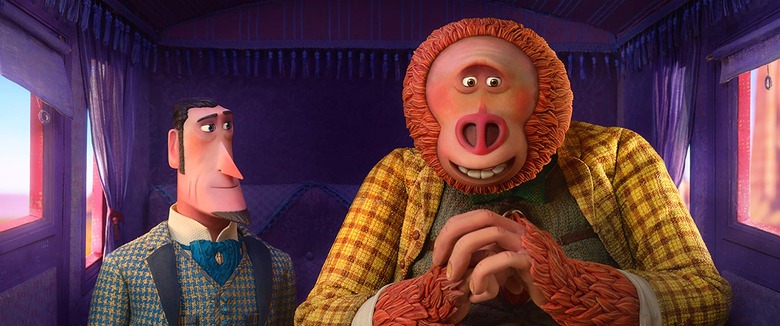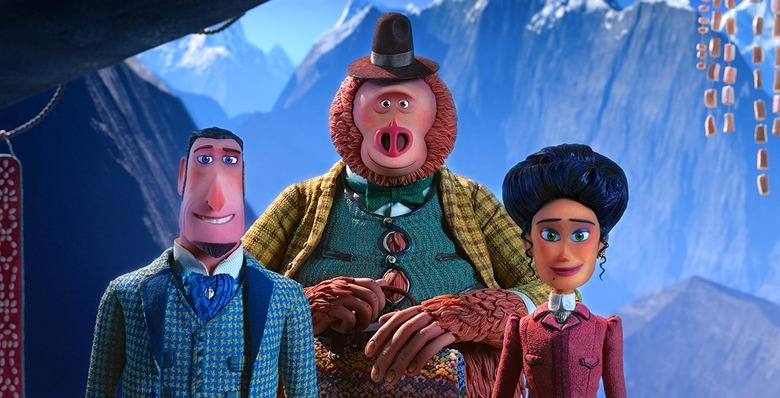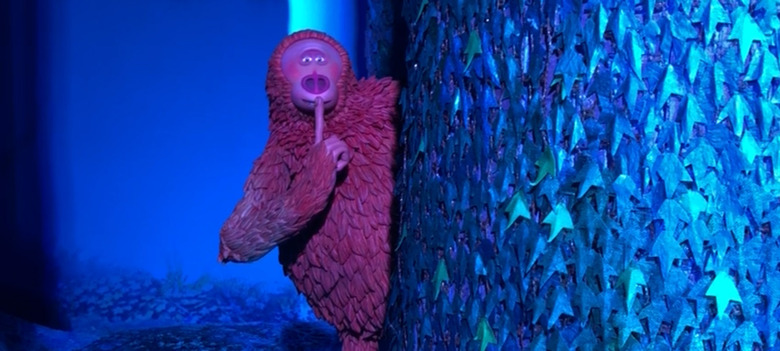How Laika Found The 'Missing Link' Between CG And Stop-Motion Animation [Set Visit Report]
Stepping into Laika's Missing Link set is like stepping into a giant dollhouse or wandering into a miniaturized movie studio. Either way, it's unlike anything I've ever experienced. The hybrid animation studio revolutionized the stop-motion game when it debuted its 3D-printed film Coraline in 2009. Since then, the independent stop-motion studio has been steadily innovating with each of its films, earning critical and awards success, and the respect from their peers in the technology fields, along the way.
"Everything we've tried a new technology, we've essentially had to rip out the engine in our racecar and replace it with something else," director of rapid prototyping Brian Mclean told a group of visiting journalists at Laika's studio in Portland, Oregon. "And the reason why we do that is normally, if not always, [we're] driven by some creative demand."
Laika's upcoming Missing Link is no exception. The latest film from the animation studio behind visionary stop-motion films like Coraline, Box Trolls, and Kubo and the Two Strings is pushing the envelope toward a naturalistic style never before achieved in stop-motion animation. "Every shot is like a visual effect," producer Arianne Sutner said of the film's jaw-dropping realism. "We want to see our characters breathing." But it's more than just innovation on a microscopic scale — Missing Link is a globe-trotting adventure that has the most epic scale out of any Laika film yet.
/Film visited the set of Missing Link at Laika with a group of other journalists to get a picture of the studio's latest feature film, which stars Hugh Jackman, Zoe Saldana, and Zach Galifianakis and is written and directed by ParaNorman's Chris Butler. The film follows ridiculed adventurer Sir Lionel Frost (Jackman) who sets off on a journey to prove existence of a legendary creature and ends up stumbling upon the amiable beast he dubs "Mr. Link" (Galifianakis), who entreats Sir Lionel to help him find others like him. Joined by the free-spirited and feisty Adelina Fortnight (Saldana), the three embark on a globe-trotting adventure on the cusp of the 20th century.
Scaling Up
With 60 different locations, 106,000 unique faces printed for each facial expression, roughly 30 puppet models per character, and 250-plus components per puppet, Missing Link is a production on a scale that Laika has never worked before. Shot over roughly 92 weeks, Missing Link had at its peak 97 units run by 31 animators, not to mention its various sub-departments like costume design, sculptures, puppets, facial prototyping, rigging, art and production design. Like any stop-motion film, you expect a level of arduous labor, but when the Missing Link team breaks down just how much work goes into the animated film, you wonder how they didn't constantly have breakdowns.
"4.3 seconds a week is the target of animated approved budget," production manager Dan Pascall said. "If you've got an action shot, that comes down to two seconds a week."
But Laika is still an independent studio, and most employees have worked on at least one of its other films. Missing Link might have the biggest scale story-wise, but many of the teams still maintain that small crew that give the films that personal touch. "For every scene we're doing we're collaborating with hundreds of people, but the stories are still personal. It's not just made by committee," Sutner said.
Production designer Nelson Lowry only had a team of four concept art designers to put together the art for the film, which proved to be one of his most challenging projects yet. "It was a challenging film overall because of the number of locations," Lowry said.
"Using a lot of reference and picking four or five locations that were as different as possible and using them as templates, so making sure they were really unified visually — an exterior in a forest, a small cabin in a ship, a study in the Casa de Fortnight — making sure they had a commonality. Then I could sort of interpolate and spread that line out and start filling in common designs."
"It's what I call Frankenstein-ing," Lowry added. "You take all the best parts and put them together even if they don't necessarily fit. We always try to keep everything based in historical, certainly culturally we do, but there's details for instance in the Pacific Northwest woods, the ivy is English ivy. We try not to get too fantasy with it though, especially in reality-based locations." Those locations were inspired by the Victorian era, which is usually thought of as a muted, subdued era of fashion and culture. Not so, Lowry said. It's in fact one of the most vibrant, colorful eras, which leant to Missing Link's signature saturated color scheme.
Bringing Color Back to the Victorian Era
"It's a kaleidoscopic color explosion," Sutner described of Missing Link's signature look. Which may be an odd way of describing a film set firmly in the Victorian era between 1890-1910, a period to which Laika took pains to stay historically accurate.
"Chris Butler had some real key visual elements that he wanted to inform [Missing Link]," Lowry said. "One was National Geographic Magazine back in the '50s and '60s, that was like bringing the world into people's homes and there was a certain printing quality back then of really rich saturated colors. And then he loved the patterning of the Victorian era. Sometimes we think of the Victorian era of sort of Dickensian or sepia or washed out, but of course back then it wasn't, it was bright and colorful and new. We wanted to bring that into it."
Like Lowry emphasized, costume designer Deborah Cook found that an abundance of color was available in the clothing and dyeing techniques of the era. "[Dyeing techniques] were kind experimental and were considered noveau and sharp, fashion-forward, Cook said. "Lionel and Adelina's costumes...fitted the uptempo color that we wanted for this movie and to fill the scope for the kind of abundance of globe-trotting color."
From the clothes, to the sets, to the character designs themselves, nothing in Missing Link is monochromatic — even a black-and-white checkered cigar club has an undercurrent of magenta to it. It's an "illustrative, sumptuous style" that Butler wanted all of the departments to adhere to, puppets lead John Craney said. For Lowry, that gave him license to go as wild on the color in his concept art and production pieces as he could — befitting the film's fantastical bent. "The color was very special and important to me because I've worked on a bunch of films that were not super colorful. So I was excited to work on something a little more commercial, bright, poppy, just happier," Lowry said, adding:
"It's a little bit daunting when you want to have a big colorful film that goes all over the world, because it can get into a zone I call the clown pants, which I don't like. It's just color everywhere! So what I try to do is break out the locations and make them have their own signature overall feel. It may not look like it now, but I keep the colors to a very limited color palette per location. And I make sure the color script follows the action so you don't go from environments that share the same color palette. Even the jungle in India and the Pacific Northwest woods, we made one very blew and one very green just so they would be different. I love that, I think it gives the film a freshness. It's a sort of clean color throughout and it's different than most films that I've done."
Defying (and Engineering) Gravity
One of rigging operator Ollie Jones' biggest challenges in Missing Link was to make stagecoach tassels move. Chris Butler had asked Jones to create a swinging movement in the tassels as the stagecoach drove down a rickety cobblestone street. It was a problem that took Jones six months to solve. "Making that commitment to detail," Jones said, "when you're inside something, it gives a life."
To make that commitment requires tons of research, Jones said, which was not how Laika used to work when they first broke out onto the scene with Coraline:
"We used to work so much more with intuition. I think if you look back at Coraline, you would see that they are more signifiers of how things would work, they're more cartoon-y or they're more symbolic. Here, we really dive into our research. And I find that it helps more and clarifies. Research is a good discussion piece, it brings you, the director, the animation supervisor, the animator all to one point, where if you just make stuff up, it becomes so much more subjective."
"With animation, we don't get any movement for free," Cook added. "Like in live-action where you have people walking around and if they move their arm, their sleeve moves with it. Does not happen here. So we have to engineer every single move." In costuming, Cook achieves that by using weights and lining in each version of a character's costume to signify a different movement and "trick the camera" with color and shape. Because Laika has become virtually a one-stop shop to manufacture and use its technology, from fabrics to rigs, the departments have gained even greater control. So while it takes several months to design and create something, "We start to build a library of formulas for that particular movie that we can draw on to populate different characters and different costumes," Cook said.
That library and the level of research that Laika dedicates to its films have become essential to achieving the realism that they wanted with Missing Link, and which they'll continue to expand upon in future films. That's why Laika stop-motion films look so different from traditional stop-motion, Craney said:
"We don't do crawl. We don't do boil. We don't want any shift in costumes, in surface. Isle of Dogs is a very different thing where you see lots of scatter, it's the sort of purest stop-motion. We're a hybrid studio and we don't go for that."
A Brand New, Yet Old, Tool
Which brings us to the centerpiece of Laika's hybrid studio: the 3D printer. "Our idea was let's take this brand new 3D printing technology, harness the power of the computer, sculpt and animate the faces within the computer and then send them to the 3D printer," Mclean said. Coraline was the first movie made with this technology, and since then, Laika has been steadily innovating and testing out new 3D printing technology. And the technology that they're using for Missing Link is their most advanced yet.
Laika worked closely with Stratasys to help develop a full-color resin printer, an evolution of the white resin printer used for Coraline and the color powder printer they used for ParaNorman, Box Trolls, and Kubo and the Two Strings. "We have made a name for ourselves in the 3D printing world and the stop-motion world, so we don't accept any product off the shelf," Mclean said. Laika ended up partnering with a research company in Germany to provide the software, which they were able to immediately put to work with Missing Link.
"This is the first film where we've been able to do highly customized facial animation, meaning very single shot of the film had a unique set of faces printed," Mclean said. Together with Craney's puppet department, which develops the armatures or robotic exoskeletons for each character, Laika was able to further hone the tool that they continue to be at the cutting edge of. "What we're really building is a tool for our actors, or our animators by proxy, to create the illusion of life," Craney said. "It's like performance from within. That's what we aim for, and we keep pushing for that with the next one." Added Mclean:
"It was a weird thing to be coming into a stop-motion studio in 2005 with this idea of using 3D printers because a lot of the stop-motion artists felt extremely threatened by CG and they suddenly saw CG coming right into their backyard and planting a foot... The irony was, once people understood that it was just another tool, it was a tool in the tool chest that once you learned how to use and you stopped being intimidated by it, it suddenly opened up the horizon to do things in a whole new way, or to do things that were done in a traditional way but just faster. We're on the cusp now where 3D printers, we use them for faces primarily, but every other department in Laika is using 3D printers for something...And these are all traditional artists who realize that it's an amazing tool."
A Departure or a New Chapter?
With the 3D technology provided by the full color resin printers, which use a technology called voxel printing, the characters' faces in Missing Link have a translucent, almost skin-like texture. When light glances off Sir Lionel's face, you can see it glowing through his pink, triangular nose — giving the film a realism that Laika has never achieved before. And it's something that can only be achieved through the intersection of stop-motion and new technology.
"I love the physicality of it," Lowry said. "And even though computers are getting wildly sophisticated, a beautifully lit set with light falling on all these different things gives a real tactile, human kind of feeling to me."
Laika films will continue to look better and better, but they can't go back, Mclean said. The new 3D printing technology actually isn't capable of printing the faces like the ones they printed for Coraline 10 years ago. ""We don't have the ability to create a Coraline face again," Mclean said. "She would probably look a little too realistic":
"The only thing I think we lose is, every time we yank out an engine and stick in a new one, the team that isn't involved in that, the rest of the production, doesn't recognize how much we have just knowingly stepped into doing things. So they get frustrated with us, going, 'You guys have been doing faces for 15, 12 years now, why is it taking you so long?' And they don't understand that we've had to essentially rebuild an entire pipeline every time we try a new technology."
Though it's a departure technologically and tonally for Laika — the film has more comedy than any of their previous features — Missing Link may be a new chapter for the animation studio.
"[Missing Link] ..is a departure," Sutner said. "But we wanted to do that departure on our terms."
Missing Link hits theaters on April 12, 2019.

